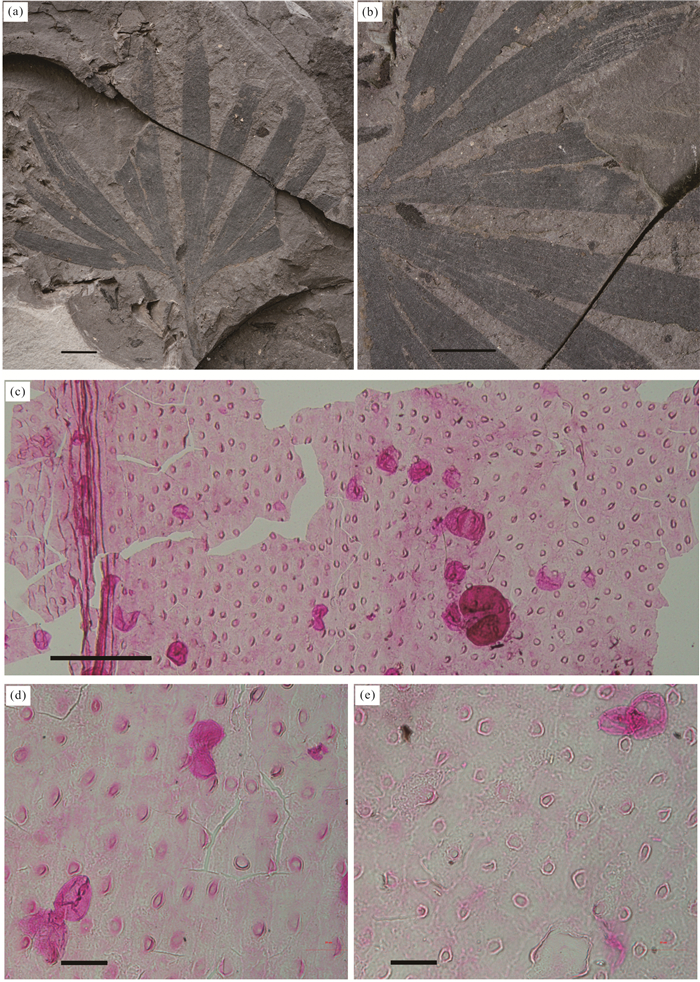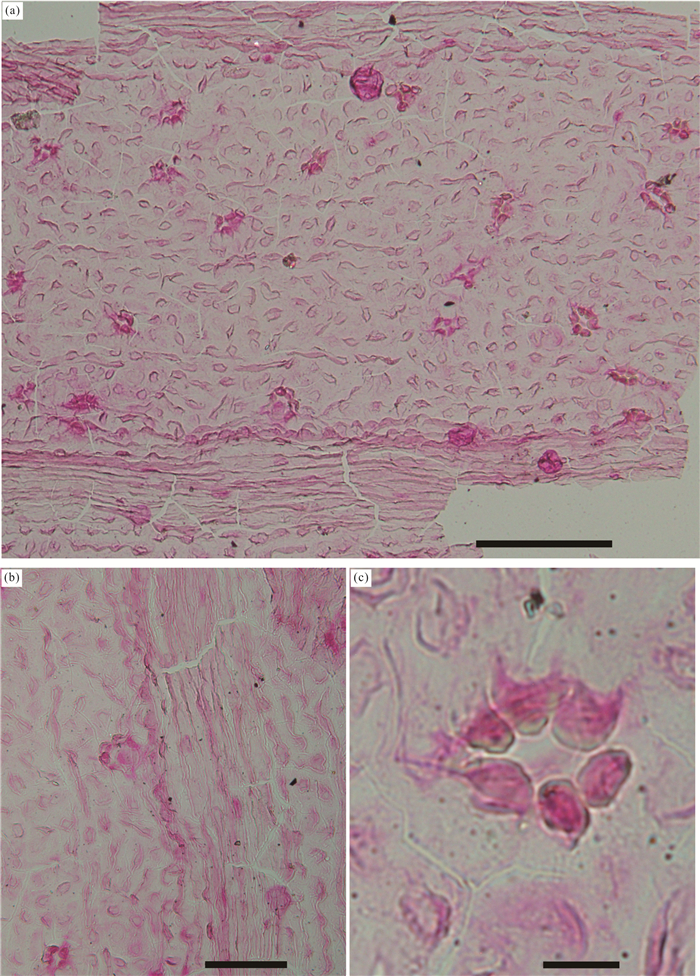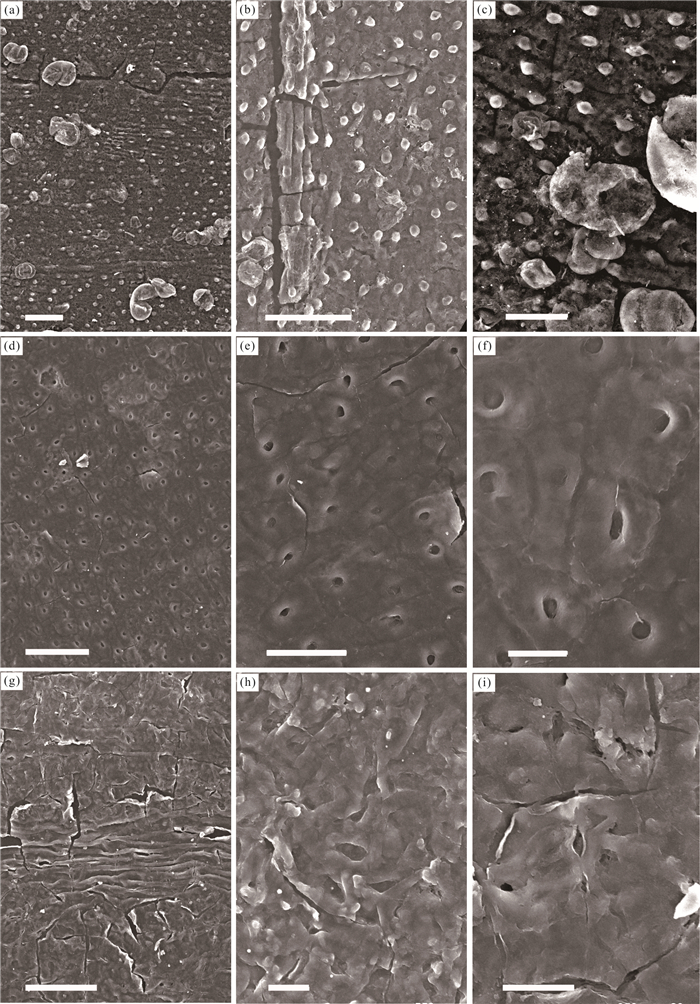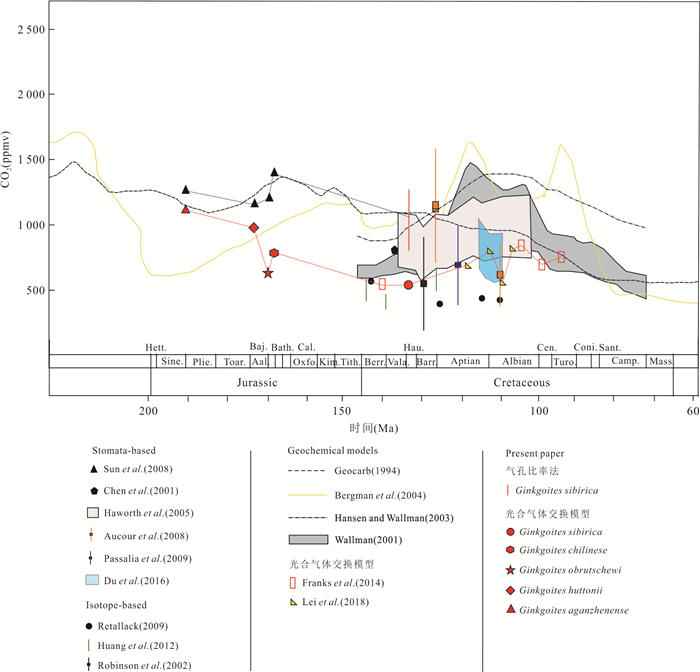Discovery of Early Cretaceous Ginkgoites in Beishan, Gansu Province: Also on Changes of Paleoatmospheric CO2 in Jurassic to Cretaceous in Gansu Province
-
摘要: 银杏类化石的微细构造是定量估算古大气二氧化碳浓度的良好材料.首次报道了甘肃北山中口子盆地早白垩世赤金堡组似银杏属化石,通过宏观和微观特征对比将其鉴定为Ginkgoites sibirica.利用气孔比率法定量重建Hauterivian-Barremian期的古大气CO2浓度为766~1 277 ppmv.结合前人数据,利用光合气体交换模型定量重建了甘肃省早侏罗世‒早白垩世古大气CO2浓度及变化趋势,侏罗纪普林斯巴期(Pliensbachian)、阿林期(Aalenian)、巴柔期早期(Early Bajocian)、巴柔期晚期(Late Bajocian)的古大气CO2浓度分别为1 136 ppmv、927 ppmv、643 ppmv和785 ppmv;早白垩世Hauterivian-Barremian期的CO2浓度为548 ppmv.结果显示早、中侏罗世二氧化碳浓度较高,向白垩纪呈下降趋势,早白垩世早中期达到低点后呈现缓慢波动上升;早白垩世晚期达到顶点,然后缓慢下降.研究表明光合气体交换模型可作为恢复古气候变化的有效手段.Abstract: Epidermal features of fossil ginkgophyta are one of the good materials for estimating the paleoatmospheric CO2 concentration. In this study, a fossil Ginkgoites species, Ginkgoites sibirica is firstly described based on leaf morphology and epidermal features from the Lower Cretaceous Chijinbao Formation in the Zhongkouzi Basin, Beishan area, Northwest China. The paleo-CO2 was 766-1 277 ppmv during the Hauterivian to Barremian based on the stomatal ratio method, which is consistent with the results of other studies. The CO2 variation trend during the Early Jurassic to the Early Cretaceous is reconstructed based on the leaf gas-exchange model in combination with previous data. The paleo-CO2 was 643-1 136 ppmv during the Jurassic and 548 ppmv during the Hauterivian to Barremian. The results show that the CO2 concentration was high in the Early and Middle Jurassic, with a decreasing trend toward the Cretaceous, and then showed a significant increase during Early and Middle Cretaceous. The paleo-CO2 reached its peak during the late Early Cretaceous, and then decreased significantly afterwards. Studies have shown that the leaf gas-exchange model can be an effective proxy for reconstructing paleoclimate.
-
Key words:
- Ginkgoites /
- paleo-CO2 /
- gas exchange model /
- quantitative reconstruction /
- Mesozoic /
- paleoclimate
-
图 4 Ginkgoites sibirica扫描电镜特征
a、b、c. Ginkgoites sibirica扫描电镜上表皮外表面特征,图a、图b的比例尺=100 μm,图c比例尺=50 μm,标本编号:19-K-2-1088;d、e、f. Ginkgoites sibirica扫描电镜上表皮内表面特征,图d比例尺=100 μm,图e比例尺=50 μm,图f比例尺=20 μm;g、h、i. Ginkgoites sibirica扫描电镜下表皮特征,图g比例尺=100 μm,图h、图i的比例尺=20 μm
Fig. 4. Scanning electron microscopic features of Ginkgoites sibirica
表 1 似银杏属化石特征对比
Table 1. Comparisons of characteristics of Ginkgoites fossils
种名 叶形 裂片数 是否具柄 裂片内叶脉数 裂片顶端 叶脉间树脂体 上表皮气孔器 下表皮 副卫细胞数量 乳突 毛基或毛状体 气孔密度(mm2) 时代 来源 脉内细胞形态 脉间细胞形态 G.shiguaiensis 半圆形至扇形 4~10 是 每5 mm有10~12条 圆钝 ‒ 少数有 ‒ ‒ 4~6 有 无 ‒ 中侏罗世 Sun et al.,2008 G.manchurica 宽楔形、半圆形 10~20或更多 是 4~5 钝圆或钝尖 ‒ 偶在叶缘有或无 伸长的细胞 不显 5~8 有 ‒ 20~25 早白垩世 斯行健和李星学,1963;周志炎等,2020 G.dayanensis 半圆形或扇形 8个以上 是 4~6,最多7 近截形 ‒ ‒ ‒ ‒ ‒ 有 有 ‒ 早白垩世 张武等,1980;邓胜徽等,1997 G.giganteus 扇形,叶片大 5个以上 是 每厘米10条 ‒ ‒ 稀少 细胞狭长,两端尖 多角形、长方形 5~6 少数有 ‒ 14~30 中侏罗世、早侏罗世 杨恕等,1988 G.lingxiensis 半圆形 12 是 4~5 钝圆形 具纵纹 无 伸长的 不规则四边形或多角形 4~6 有 偶见毛状体 ‒ 早白垩世 郑少林和张武,1982 G.myrioneurus 扇形 通常10~12,最多可达18 细长 每厘米达20~30条或更多 ‒ 偶见 ‒ ‒ 6~8 有 ‒ ‒ 早白垩世 Yang,2004 G.taeniatus 扇形至宽扇形 4~8 有 4~8,宽达10 钝尖至钝圆 ‒ ‒ ‒ ‒ ‒ ‒ ‒ ‒ 早、中侏罗世, 晚三叠世 斯行健,1959 G.tasiakouensis 扇形或纵伸的半圆形至半椭圆形 8 细长 3~5 钝圆形并具一微小的缺刻 ‒ 多生于上表皮 矩形或长矩形 多边形 5~6 有的有 ‒ ‒ 早、中侏罗世 Yang et al.,2014 G.chilinensis 扇形 6或更多 是 6~10 ‒ 偶见 伸长的 圆形或椭圆形 5~6 有 ‒ ‒ 早白垩世 斯行健和李星学,1963 G.sibirica 半圆形或扇形 8~10或12~14,少数6~8 具长柄 3~8 钝圆或渐尖 ‒ 无 伸长的多角形 方形或不规则形 5~6 有 无 70~80 早白垩世 Heer,1876;Seward,1919;周志炎等,2020 G.sibirica 扇形至半圆形 10 是 5~6 钝圆或钝尖 无 长条状 不规则形 4~6 有 无 125~155 早白垩世 本文 表 2 本文标本与西伯利亚似银杏特征对比
Table 2. Comparison of characteristics between the specimens and Ginkgoites sibirica
种名 Ginkgoites sibirica 本文 叶分裂次数 3~4 3~4 裂片数 8~10 10 裂片叶脉数 4~9 5~6 裂片顶端 钝圆或渐尖 钝圆或钝尖 上表皮气孔器 无 无 气孔器形状 圆形、椭圆形 圆形、椭圆形 气孔器大小 35 μm×42 μm (31~35)μm×(37~43)μm 保卫细胞形状 半月形 括号形、肾形 副卫细胞数量 4~5 4~6 乳突 所有细胞均有 所有细胞均有 资料来源 Heer,1876;Seward,1919;周志炎等,2020 本文 表 3 Ginkgoites sibirica植物气孔参数
Table 3. Plant stomatal data of Ginkgoites sibirica
种属 标本编号 SD (mm2) ED (mm2) SI (%) SR 石炭纪标准 最新标准 RCO2 PCO2(ppmv) RCO2 PCO2(ppmv) G. sibirica 19-K-2-1088 129 2 367 5.17 2.19 4.38 1 315 2.63 789 134 2 405 5.28 2.15 4.29 1 288 2.58 773 142 2 431 5.52 2.05 4.11 1 232 2.46 739 155 2 705 5.42 2.09 4.18 1 254 2.51 753 127 2 301 5.23 2.17 4.33 1 300 2.60 780 145 2 598 5.29 2.14 4.29 1 286 2.57 772 133 2 312 5.44 2.08 4.17 1 250 2.50 750 18-K-2-498 125 2 296 5.16 2.19 4.39 1 317 2.63 790 151 2 594 5.50 2.06 4.12 1 236 2.47 741 128 2 363 5.14 2.20 4.41 1 323 2.65 794 148 2 571 5.44 2.08 4.16 1 249 2.50 749 均值 138±11 2 449±143 5.33±0.14 2.13±0.06 4.26±0.11 1 277±34.15 2.55±0.07 766±20.49 表 4 前人与本文恢复CO2浓度对比
Table 4. Comparison of CO2 concentration restored by predecessors and this paper
种属 时代 恢复CO2的值(ppmv) 出处 Ginkgoites Hauterivian-Barremian 766~1 277 本文 Gingko Valanginian-Hauterivian 740 Chen et al., 2001 Pseudofrenelopsis Barremian-Aptian 560~1 200 Haworth et al., 2005 Pseudofrenelopsis Cenomanian 861~1 047 任文秀等, 2008 Frenelopsis Late Barremian 737~1 567 Aucour et al., 2008 Brachyphyllum Barremian-Aptian 700~1 400 Passalia, 2009 Brachyphyllum Late Aptian-Early Albian 531~1 060 Du et al., 2016 Pseudofrenelopsis 558~959 表 5 侏罗世‒早白垩世似银杏属植物气孔解剖数据及古大气CO2浓度重建
Table 5. Stomatal anatomical data of Ginkgoites plants and reconstruction of paleoatmospheric CO2 concentration during the Jurassic to Early Cretaceous
层位 统计量 D(mm2) l(μm) p(μm) δ13Cp δ13Ca Ci/Ca An gc(tot) CO2(ppmv) K1ch 15 139 12.3 5.15 ‒22.29 ‒4.50 0.53 10.71 0.04 518 14 138 10.7 5.06 ‒22.08 ‒4.50 0.53 10.90 0.04 579 J2y5 9 73 18.35 4.34 ‒26.70 ‒5.60 0.68 11.43 0.04 785 J2y4 10 82 18.09 4.22 ‒25.70 ‒5.60 0.63 11.15 0.05 643 J2y2 20 67 17.77 4.12 ‒27.40 ‒5.70 0.70 11.76 0.04 927 J1dx 4 37 11.75 5.30 ‒20.60 ‒6.10 0.41 12.01 0.02 1 136 注:J2y2、J2y4、J2y5中的δ13Cp的数据来源于 Sun et al.,2008 ,其他数据为本文的分析和统计数据;δ13Ca取值来自Beerling et al.,2002 .表 6 基于甘肃地区似银杏化石恢复的中侏罗世‒早白垩世古大气CO2浓度对比
Table 6. Comparison of paleoatmospheric CO2 concentration from Middle Jurassic to Early Cretaceous based on the restoration of Ginkgoites fossils in Gansu
地层 属种 时代 恢复的CO2浓度(ppmv) 出处 气孔比率法(石炭标准) 光合气体交换模型 K1ch Ginkgoites sibirica Hauterivian-Barremian 1 277 548 本文 J2y5 Ginkgo chilinense Late Bajocian 1 370* 785 J2y4 Ginkgo obrutschewi Early Bajocian 1 231* 643 J2y2 Ginkgo huttonii Aalenian 1 190* 927 J1dx Ginkgo aganzhenense Pliensbachian 1 252* 1 136 注:*结果出自Sun et al.(2008),其他为本文重新统计、计算得出. -
Aucour, A. M., Gomez, B., Sheppard, S. M. F., et al., 2008. δ13C and Stomatal Number Variability in the Cretaceous Conifer Frenelopsis. Palaeogeography, Palaeoclimatology, Palaeoecology, 257(4): 462-473. https://doi.org/10.1016/j.palaeo.2007.10.027 Beerling, D. J., Royer, D. L., 2002. Fossil Plants as Indicators of the Phanerozoic Global Carbon Cycle. Annual Review of Earth and Planetary Sciences, 30: 527-556. https://doi.org/10.1146/annurev.earth.30.091201.141413 Bergman, N. M., Lenton, T. M., Watson, A. J., 2004. COPSE: A New Model of Biogeochemical Cycling over Phanerozoic Time. American Journal of Science, 304(5): 397-437. https://doi.org/10.2475/ajs.304.5.397 Berner, R. A., 1994. GEOCARB Ⅱ: A Revised Model of Atmospheric CO2 over Phanerozoic Time. American Journal of Science, 294(1): 56-91. https://doi.org/10.2475/ajs.294.1.56 Chen, L. Q., Li, C. S., Chaloner, W. G., et al., 2001. Assessing the Potential for the Stomatal Characters of Extant and Fossil Ginkgo Leaves to Signal Atmospheric CO2 Change. American Journal of Botany, 88(7): 1309-1315. https://doi.org/10.2307/3558342 Deng, S. H., 1997. Early Cretaceous Flora of Hailar, Inner Mongolia, China. Geological Publishing House, Beijing, 251-255 (in Chinese). Du, B. X., Sun, B. N., Zhang, M. Z., et al., 2016. Atmospheric Palaeo-CO2 Estimates Based on the Carbon Isotope and Stomatal Data of Cheirolepidiaceae from the Lower Cretaceous of the Jiuquan Basin, Gansu Province. Cretaceous Research, 62: 142-153. https://doi.org/10.1016/j.cretres.2015.07.020 Franks, P. J., Beerling, D. J., 2009. Maximum Leaf Conductance Driven by CO2 Effects on Stomatal Size and Density over Geologic Time. Proceedings of the National Academy of Sciences of the United States of America, 106(25): 10343-10347. https://doi.org/10.1073/pnas.0904209106 Franks, P. J., Royer, D. L., Beerling, D. J., et al., 2014. New Constraints on Atmospheric CO2 Concentration for the Phanerozoic. Geophysical Research Letters, 41(13): 4685-4694. https://doi.org/10.1002/2014gl060457 Hansen, K. W., Wallmann, K., 2003. Cretaceous and Cenozoic Evolution of Seawater Composition, Atmospheric O2 and CO2: A Model Perspective. American Journal of Science, 303(2): 94-148. https://doi.org/10.2475/ajs.303.2.94 Haworth, M., Hesselbo, S. P., McElwain, J. C., et al., 2005. Mid-Cretaceous pCO2 Based on Stomata of the Extinct Conifer Pseudofrenelopsis (Cheirolepidiaceae). Geology, 33(9): 749-752. https://doi.org/10.1130/g21736.1 Heer, O., 1876. Beiträge zur Jura-Flora Ostsibiriens und des Amurlandes. Académie Impériale des Sciences, 22(2): 1-122. Huang, C. M., Retallack, G. J., Wang, C. S., 2012. Early Cretaceous Atmospheric pCO2 Levels Recorded from Pedogenic Carbonates in China. Cretaceous Research, 33(1): 42-49. https://doi.org/10.1016/j.cretres.2011.08.001 Jin, P. H., 2018. Early Cretaceous Plant Fossils and Paleoecological Characteristics in Laiyang, Shandong Province (Dissertation). Lanzhou University, Lanzhou (in Chinese with English abstract). Lei, X. T., Du, Z., Du, B. X., et al., 2018. Middle Cretaceous pCO2 Variation in Yumen, Gansu Province and Its Response to the Climate Events. Acta Geologica Sinica (English Edition), 92(2): 801-813. https://doi.org/10.1111/1755-6724.13555 Li, H. W., Dong, M., Tian, N., et al., 2022. Paleoenvironmental Implications of the Middle Jurassic Phoenicopsis Angustifolia Heer in Shaerhu, Xinjiang. Earth Science, 47(2): 532-543 (in Chinese with English abstract). Li, J., Yang, Q., Chen, H., et al., 2019. The Middle Jurassic Ginkgophyte Fossils from Huating, Gansu and Their Stomatal Parameters Responding to Paleoatmospheric CO2. Journal of Lanzhou University (Natural Sciences), 55(5): 561-570 (in Chinese with English abstract). Li, Y. X., Kang, Z. Q., Xu, J. F., et al., 2023. Chronological, Geochemical Characteristics and Geological Significance of Volcanic Rocks in the Late Early Cretaceous in Southeast Guangxi. Earth Science, 48(8): 2872-2887 (in Chinese with English abstract). Lin, Z. C., Sun, B. N., Wu, J. Y., et al., 2012. New Proxy for Atmospheric Paleo-CO2 Level during Phanerozoic: Carbon Isotope Discrimination of Fossil Liverworts. Earth Science, 37(1): 145-155 (in Chinese with English abstract). Passalia, M. G., 2009. Cretaceous pCO2 Estimation from Stomatal Frequency Analysis of Gymnosperm Leaves of Patagonia, Argentina. Palaeogeography, Palaeoclimatology, Palaeoecology, 273(1-2): 17-24. https://doi.org/10.1016/j.palaeo.2008.11.010 Quan, C., Sun, C. L., Sun, Y. W., et al., 2009. High Resolution Estimates of Paleo-CO2 Levels through the Campanian (Late Cretaceous) Based on Ginkgo Cuticles. Cretaceous Research, 30(2): 424-428. https://doi.org/10.1016/j.cretres.2008.08.004 Quan, C., Zhang, L., 2005. An Analysis of the Early Paleogene Climate of the Jiayin Area, Heilongjiang Province. Geological Review, 51(1): 10-15 (in Chinese with English abstract). Ren, W. X., Sun, B. N., Li, X. C., et al., 2008. Microstructures of Two Species of Cheirolepidiaceae from Cretaceous in Zhejiang, China and Its Paleoenvironmental Significance. Acta Geologica Sinica, 82(5): 577-583 (in Chinese with English abstract). doi: 10.3321/j.issn:0001-5717.2008.05.001 Retallack, G. J., 2001. A 300-Million-Year Record of Atmospheric Carbon Dioxide from Fossil Plant Cuticles. Nature, 411(6835): 287-290. https://doi.org/10.1038/35077041 Retallack, G. J., 2009. Greenhouse Crises of the Past 300 Million Years. Geological Society of America Bulletin, 121(9-10): 1441-1455. https://doi.org/10.1130/b26341.1 Robinson, S. A., Andrews, J. E., Hesselbo, S. P., et al., 2002. Atmospheric pCO2 and Depositional Environment from Stable-Isotope Geochemistry of Calcrete Nodules (Barremian, Lower Cretaceous, Wealden Beds, England). Journal of the Geological Society, 159(2): 215-224. https://doi.org/10.1144/0016-764901-015 Seward, A. C., 1919. Fossil Plants: A Text-Book for Students of Botany and Geology. Cambridge University Press, London. Si, X. J., 1959. Jurassic Flora of Qaidam, Qinghai Province. Acta Palaeontologica Sinica, 7(1): 1-31 (in Chinese). Si, X. J., Li, X. X., 1963. Mesozoic Plants of China (Fossil Plants of China). Science Press, Beijing (in Chinese). Sun, B. N., Xiao, L. A., Xie, S. P., et al., 2007. Quantitative Analysis of Paleoatmospheric CO2 Level Based on Stomatal Characters of Fossil Ginkgo from Jurassic to Cretaceous in China. Acta Geologica Sinica (English Edition), 81(6): 931-939. https://doi.org/10.1111/j.1755-6724.2007.tb01016.x Sun, B. N., Xie, S. P., Yan, D. F., et al., 2008. Fossil Plant Evidence for Early and Middle Jurassic Paleoenvironmental Changes in Lanzhou Area, Northwest China. Palaeoworld, 17(3-4): 215-221. https://doi.org/10.1016/j.palwor.2008.09.002 Wallmann, K., 2001. Controls on the Cretaceous and Cenozoic Evolution of Seawater Composition, Atmospheric CO2 and Climate. Geochimica et Cosmochimica Acta, 65(18): 3005-3025. https://doi.org/10.1016/S0016-7037(01)00638-X Wang, J., Ren, W. X., Li, T. G., et al., 2020. Environment and Tectonic Evolution during Early Cretaceous in Yumen Basin: Evidence from Silicified Woods in Northern Margin of Tibetan Plateau. Earth Science, 45(11): 4143-4152 (in Chinese with English abstract). Wang, Y. D., Huang, C. M., Sun, B. N., et al., 2014. Paleo-CO2 Variation Trends and the Cretaceous Greenhouse Climate. Earth-Science Reviews, 129: 136-147. https://doi.org/10.1016/j.earscirev.2013.11.001 Wu, J. Y., Ding, S. T., Li, Q. J., et al., 2016. Reconstructing Paleoatmospheric CO2 Levels Based on Fossil Ginkgoites from the Upper Triassic and Middle Jurassic in Northwest China. Paläontologische Zeitschrift, 90(2): 377-387. https://doi.org/10.1007/s12542-016-0300-1 Yang, S., Sun, B. N., Shen, G. L., 1988. New Materials of Ginkgoites from Jurassic in Vicinity of Lanzhou, Gansu. Journal of Lanzhou University, 24(S1): 70-77 (in Chinese with English abstract). Yang, X. J., 2004. Ginkgoites myrioneurus sp. nov. and Associated Shoots from the Lower Cretaceous of the Jixi Basin, Heilongjiang, China. Cretaceous Research, 25(5): 739-748. https://doi.org/10.1016/j.cretres.2004.06.006 Yang, X. J., Wu, X. W., Zhou, Z. Y., 2014. On the Nomenclatural Problems of Some Chinese Ginkgoalean Fossil Plants. Acta Palaeontologica Sinica, 53(3): 263-273. Zhang, M. Z., 2014. Environmental and Ecological Evolution Recorded by Sporopollen Flora in East Asia Continent in Late Mesozoic (Dissertation). Lanzhou University, Lanzhou (in Chinese with English abstract). Zhang, W., Zhang, Z. C., Zheng, S. L., 1980. Paleontological Atlas of Northeast China, Ⅱ. Mesozoic Cenozoic. Geological Publishing House, Beijing (in Chinese). Zheng, S. L., Zhang, W., 1982. Fossil Plants from Longzhaogou and Jixi Groups in Eastern Heilongjiang Province. Bulletin of the Shenyang Institute of Geology and Mineral Resources, 5: 277-349 (in Chinese with English abstract). Zhou, Z. Y., Yang, X. J., Wu, X. W., 2020. Palaeobotanica Sinica: Ginkgophytes. Science Press, Beijing (in Chinese). 邓胜徽, 1997. 内蒙古海拉尔地区早白垩世植物群. 北京: 地质出版社, 251-255. 金培红, 2018. 山东莱阳早白垩世植物化石及古生态特征(博士学位论文). 兰州: 兰州大学. 栗惠文, 董曼, 田宁, 等, 2022. 新疆沙尔湖中侏罗世狭叶拟刺葵(Phoenicopsis angustifolia Heer)的古环境意义. 地球科学, 47(2): 532-543. doi: 10.3799/dqkx.2021.165 李军, 杨倩, 陈慧, 等, 2019. 甘肃华亭中侏罗世银杏类化石及其气孔参数对古大气CO2的响应. 兰州大学学报(自然科学版), 55(5): 561-570. 李衣鑫, 康志强, 许继峰, 等, 2023. 桂东南早白垩世晚期火山岩年代学、地球化学特征及地质意义. 地球科学, 48(8): 2872-2887. doi: 10.3799/dqkx.2021.219 林志成, 孙柏年, 吴靖宇, 等, 2012. 恢复地史时期大气CO2浓度的新指标: 苔藓植物化石. 地球科学, 37(1): 145-155. doi: 10.3799/dqkx.2012.014 全成, 张林, 2005. 黑龙江嘉荫地区古近纪早期古气候分析. 地质论评, 51(1): 10-15. 任文秀, 孙柏年, 李相传, 等, 2008. 浙江白垩系两种掌鳞杉科化石微细结构及其古环境意义. 地质学报, 82(5): 577-583. 斯行健, 1959. 青海柴达木侏罗纪植物群. 古生物学报, 7(1): 1-31. 斯行健, 李星学, 1963. 中国中生代植物(中国植物化石第二册). 北京: 科学出版社. 王军, 任文秀, 李通国, 等, 2020. 青藏高原北缘玉门红柳峡硅化木成因及其揭示的早白垩世构造及环境. 地球科学, 45(11): 4143-4152. doi: 10.3799/dqkx.2020.002 杨恕, 孙柏年, 沈光隆, 1988. 兰州地区侏罗纪似银杏属的新材料. 兰州大学学报, 24(S1): 70-77. 张明震, 2014. 晚中生代东亚大陆内部孢粉植物群记录的环境、生态演化(博士学位论文). 兰州: 兰州大学. 张武, 张志诚, 郑少林, 1980. 东北地区古生物图册(二): 中新生代分册. 北京: 地质出版社. 郑少林, 张武, 1982. 黑龙江省东部龙爪沟群及鸡西群植物化石. 沈阳地质矿产研究所所刊, 5: 277-349. 周志炎, 杨小菊, 吴向午, 2020. 中国古植物志·银杏植物. 北京: 科学出版社. -









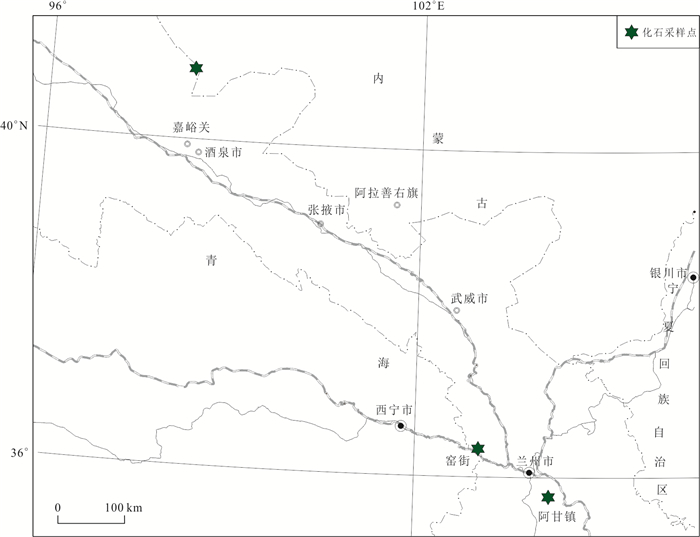
 下载:
下载:
